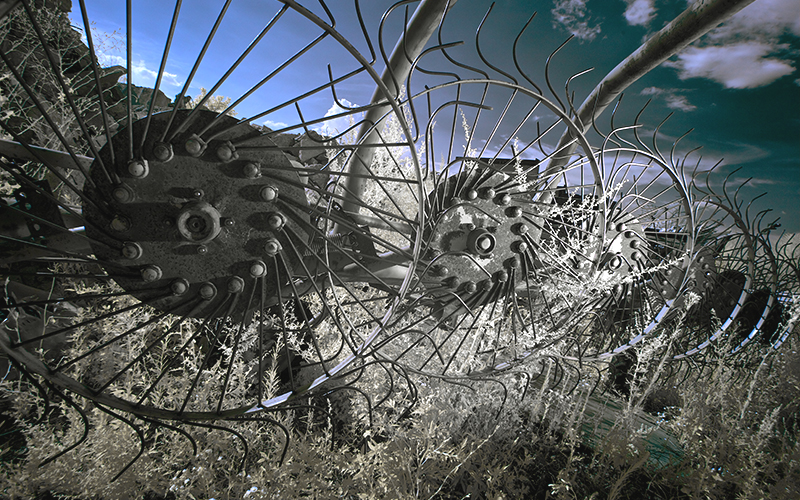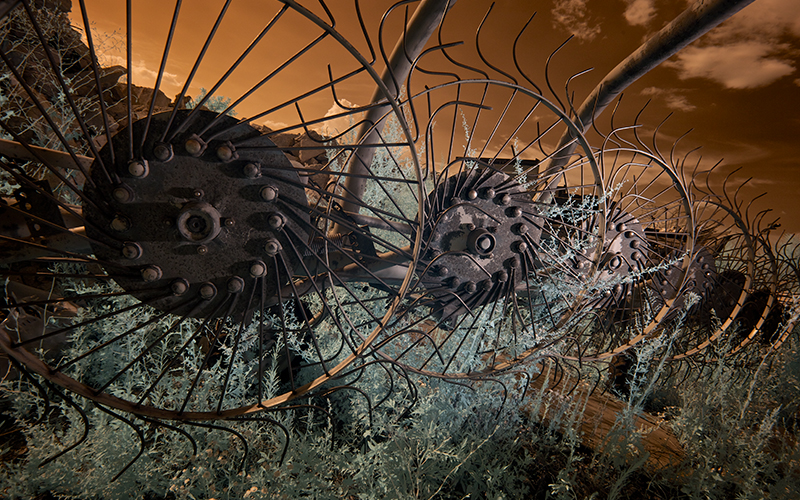Photography tipsInfrared photo
-
Circumstance
Sunny afternoon in summer. Strong sunshine providing harsh shadow and contrast.
-
Composition
This picture is far from standard ones with strong lines and strange tones. This side of the wheel rake was in shadow but an off-camera flash was used to show the details.
Canon EOS 5D EF 17-40mm f/4L USM
Infrared Artificial colors
Digital cameras contain an Infra Red (IR) filter inside, in front of the sensor because the sensors in the DSRLs are sensitive for the IR lights, which would spoil regular photos. The IR filter can be removed and let IR to reach the sensor, which provides a special combination of visible and the IR light. The most eye-catching effect on the infrared photos is the tan coloured sky and the light bluish-green vegetation (see the original picture above). If the picture is changed to B&W then the sky turns darker and the foliage is much lighter than it is expected from a regular B&W photo. Actually, IR photos provide a good chance to make images where the spectator feels that something is not natural but it takes time to recognize what is the reason of this strange impression. Just turning the picture into B&W the sky becomes stormy dark like and the vegetation seems like it would be covered by snow. However, instead of a simple B&W conversion we can play with the colour channels that provide much more interesting effect. The basic conversion contains two steps. The first step is to interchange the red and blue (RGB) channels, when the vegetation turns straw-coloured (in some case with a bit orange) and the sky turns into deep blue. The second step is to de-saturate the vegetation turning it to almost white. The final result of the two-step process can be seen in the photo above.
Off-camera flash
The wheel rake used to be used to collect hay or straw into windrows for later collection but it out of daily usage and it is staying in an industrial site. I have found a good position to take a picture on the shadowed side of the wheel rake. The ambient light was quite harsh in the summer afternoon with high contrast. To compensate the strong light I used a flash on the shadowed side of the rake as I would have done in case of regular photo. The effect of the flash is a bit different from the one of ordinary photography because its colour temperature is affected by infrared lights, as well. The flash was situated in the right side of the camera, so nice shadows emphasize the details and structure of the machine.
Colouring
Originally the wheel rake is used to gather cut straw or hay if it completely dried out, where straw-coloured field is expected to be seen. However, this machine was found in a abandoned surrounding in a strong green vegetation. The old unused overgrown wheel rake is provided a good situation to take an infrared photo and manipulate the colours, where the white vegetation gives extraterrestrial feeling. The strange effect of the picture is enhanced with the strong blue sky and its “reflection” on the wheels.
Composition
The whole machine was constructed not only with wheels but also robust bars, as well. I focused on the wheels lined up through the picture but also the thick metal bars above the wheels gives a guide to the middle wheel. Considering the colour manipulation, the sky gets an important role and also the blue reflections on the wheels highlight the colour structure. The colour structure of the sky is also provides a good opportunity to give dramatic effect to the picture because the right hand side of the photo is dark that is strengthen by the lack of the IR filter. Several effects and manipulation were put together in this picture which gives an unusual impression and emphasize the composition and also the used to have function of the wheel rake that have been getting old in the past years.



